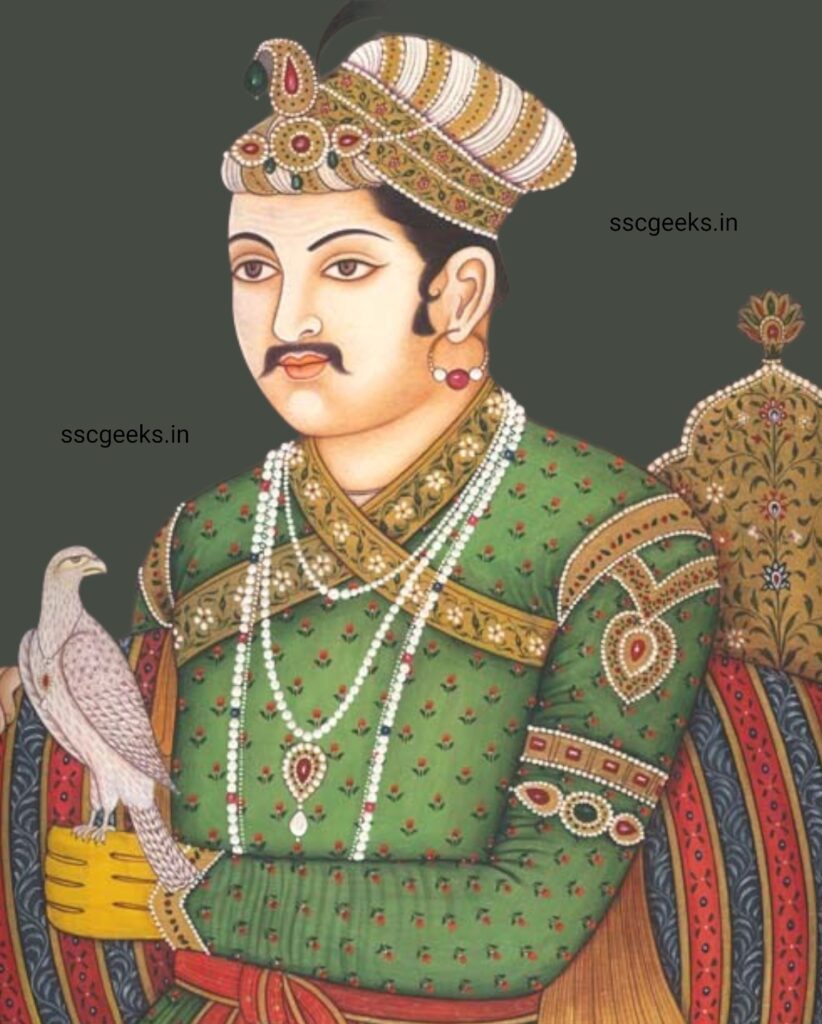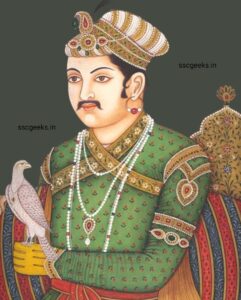Akbar the Great was born on November 23, 1542 (the 4th day of Rajab, 949 according to Hijri) in Umerkot, Sindh (modern-day Pakistan) in the palace of Rajput ruler Rana Amarsal. Akbar could not read or write; he could only take military education. He spent most of his time hunting, racing, dueling, wrestling, and so on; he was uninterested in education. Actually, Akbar was not interested in reading and writing; he was more interested in pigeon hunting, horse riding, and dog breeding, but he was always interested in learning. It is said that when he used to go to sleep, a person used to read something to him. Over time, Akbar emerged as a mature and sensible ruler with a keen interest in art, architecture, music, and literature.
Early life of Akbar the Great:

Coronation:
Akbar’s coronation took place on February 14, 1556. The 13-year-old Akbar was enthroned on a newly built platform in Kalanaur, Punjab, in golden robes and a dark turban. This platform is still in use today.He was called Shahenshah, the Persian word for emperor. His kingdom went under the protection of Bairam Khan till he became an adult.
Expansion of State:
Akbar began expanding his empire and annexed Malwa in 1562, Gujarat in 1572, Bengal in 1574, Kabul in 1581, Kashmir in 1586, and Khandesh in 1601. Akbar appointed a governor in each of these states. Akbar did not want the centre of the Mughal Empire to be in a distant city like Delhi, so he decided to shift the Mughal capital to Fatehpur Sikri, which was in the middle of the empire. After some time, Akbar had to shift the capital from Fatehpur Sikri. It is said that the lack of water was the main reason for this. After Fatehpur Sikri, Akbar created a mobile court that travelled across the empire, thus making it possible to pay proper attention to all corners of the empire. In 1585, Akbar made Lahore the capital for the smooth governance of the northwest state. Before his death, Akbar established Agra as his capital in 1599 and ruled from there until his death.
Administration:
During his reign, he successfully repelled the powerful Pashtun descendant Sher Shah Suri’s attacks and defeated the newly proclaimed Hindu king Hemu in the second battle of Panipat (1556). It took Akbar two decades to establish his empire and bring all the regions of northern and central India under one roof. He had influence over almost the entire Indian subcontinent and ruled a large part of the region as an emperor. As emperor, Akbar made diplomatic relations with the powerful and majority Hindu Rajput kings and also married their daughters. In 1560, he assumed power and expelled his patron, Bairam Khan.

Currency:
Akbar introduced copper, silver, and gold currencies during his reign. The reverse side of these coins used to have beautiful Islamic printing. Akbar made many changes to the currencies of his time. He introduced an open minting system in which anyone who was able to pay the mint fee could exchange Akbar’s currency for any other currency or gold. Akbar wanted the same currency to be used throughout his empire.
Matrimony:
Raj Bharmal, a Kachwaha Rajput of Amber , entered Akbar’s court shortly after assuming his kingdom. He agreed to get his princess, Harkhabai, married to Akbar. After marriage, she became a Muslim and was called Maryam-uz-Zamani. She was abandoned by the Rajput Family forever, after marriage she never went back to Amer. She did not even get any important place in Agra or Delhi after marriage , but got a small village in Bharatpur district . She died in 1623. A mosque was built in her honour by her son Jahangir at Lahore . Bharmal got a high position in Akbar’s court and after that his son Bhagwant Das and grandson Mansingh also remained high vassals of the court. Cases of Hindu princesses marrying Muslim kings were quite frequent before Akbar’s time, but after most of the marriages the relations between the two families were not good and neither the princesses ever returned home. However, Akbar made this case different from previous episodes, where the brothers or fathers of those queens received the same respect as Akbar’s Muslim in-laws after the daughters or sisters were married. Other Rajpur Rajwads also made matrimonial relations with Akbar, but there was no condition to make marriage relations. The two major Rajput clans, the Shishodiyas of Mewar and the Hada clans of Ranthambore , always shied away from these relations. Raja Mansingh , a famous courtier of Akbar he also took a relation proposal on behalf of Akbar to a Hadha king Surjan Hadha, which was accepted by Surjan Singh on the condition that he would not marry any of his daughters to Akbar. Ultimately no matrimonial relations took place but Surjan was honoured by handing over the charge of Garh-Katang.
Religion:
Akbar was a Muslim , but he had respect for other religions and sects as well. As Akbar’s age increased, so did his interest in religion. He is especially known for his attachment to Hinduism . Unlike his forefathers, he married many Hindu princesses. Apart from this, Akbar also appointed Hindus to various royal positions in his kingdom, which was not done by any former Muslim ruler. He had come to know that in order to rule India for a long time, he should give a proper and equal place to the natives here.
Din-I-Ilahi:
Akbar created a new religion under the name Din-i-Ilahi, which included the basic elements of all religions, mainly Hinduism and Islam. Apart from these , the basic ideas of Zoroastrianism , Jainism and Christianity were also included. Although he did not do much industry for the promotion of this religion, only his trusted people were included in it. It is said that apart from Akbar, only Birbal was his follower till his death. According to Dabestan-e-Mazhab, only 19 people adopted this religion after Akbar.
Akbar’s Navaratna:
Despite being illiterate, Akbar had special love for artists and intellectuals. Due to his love, there were nine (9) very talented courtiers in Akbar’s court, who are also known as Navratna of Akbar. [78] [79]
- Abul Fazl (1551 – 1602) penned the period of Akbar. He also composed Akbarnama . He also composed Ain-e-Akbari .
- Faizi (1547 – 1595) was the brother of Abul Fazl. He used to write poetry in Farsi . King Akbar appointed him as the mathematics teacher of his son.
- Miya Tansen was a singer in Akbar’s court. He also used to write poetry.
- Raja Birbal (1528 – 1583) was the court jester and advisor to Akbar. He is called supremely intelligent. His stories with Akbar are still told today.
- Raja Todermal was the finance minister of Akbar. He had prepared the world’s first land accounting and measurement system.
- Raja Man Singh was the Kachwaha Rajput king of Amber ( Jaipur ). He was the chief commander in Akbar’s army.
- Abdul Rahim Khan-i-Khana was a poet and the son of Akbar’s patron Bairam Khan.
- Fakir Azion-Din was the advisor of Akbar.
- Mullah Do Piaza was an advisor to Akbar.
Death of Akbar:
On October 3, 1605, Akbar contracted dysentery and never recovered. He is believed to have died on October 27, 1605. He was buried in his mausoleum at Sikandra, Agra. It is located 1 km away from the tomb of his favourite and chief consort Mariamu -Uz – Zamani
